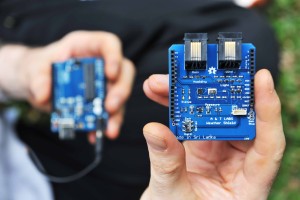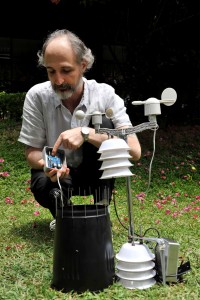Extreme and sudden weather variations in Sri Lanka make it difficult to accurately predict natural hazards like floods and landslides. But a low-cost and portable weather station, recently designed by IWMI, could raise the alarm before these events occur, significantly reducing the destruction and loss of life.
This new device, known simply as a Mobile Weather Station, was designed by IWMI scientist Yann Chemin to capture and transmit near real-time weather data. It is made primarily from locally-sourced materials, and costs about Rs 32,000. It is being developed as an open-source product, meaning the design will be freely available online for anyone to use. For Chemin, this is essential for the product’s success. “By making these designs open-source, we’re giving the power of customization to people,” he explains.

Chemin had the idea to develop the weather station during a visit to Sri Lanka’s southern coast. “It was a hot, sunny day; there wasn’t a single cloud in the sky,” he said, “but when I checked the weather using an app on my phone, it told me it was cloudy and raining. It was completely inaccurate.”
For Chemin, the solution was relatively simple: increase the number of weather stations on the island to improve the accuracy of weather reporting. The implications could be enormous – from more useful traffic announcements on the radio to better advance warning systems for floods.

The Mobile Weather Stations provide useful information for scientists, farmers and disaster management officers. In the event of heavy rains, automated SMS alerts could be sent to people living in areas at risk of landslides. Similar warnings could be sent to those in charge of the country’s many irrigation reservoirs, known as ‘tanks’.
“It would give the tank managers advance warning to prepare for higher-than-usual flows of water into the tank system,” continues Chemin. “They could take action to release water elsewhere along the network to that the system doesn’t become overwhelmed and flood. There’s no rocket science in that; by capturing and sharing the information quickly, we’re simply giving people much more time to act.”
The Stations are equipped with an atomic clock to give precise time and date readings, and a GPS sensor, which updates automatically if they are moved. Chemin is devising a system for connecting them to Sri Lanka’s mobile phone network to transfer the data. They are powered by a single solar panel, connected to a standard motorbike battery and charger. According to Chemin, this means “any electrician can fix anything that goes wrong with the power system.”
A central principle in their design is that they are cheap to produce and made from parts that are easy to source and replace. Chemin says about 80% of the components can be produced in Sri Lanka. He built the first prototype with most of the components purchased in Pettah. Only the sensors need to be imported, together with the plastic housing, which he bought online. The circuit boards are produced by a new electronics company in Colombo, while local blacksmiths can easily make the metal stands for the devices to rest on.
There are currently three Mobile Weather Stations being trialed in the north of the country, and the Meteorological Department of Sri Lanka is due to test a fourth at its headquarters in Colombo. An additional 10 devices are being produced in conjunction with the Lanka Rainwater Harvesting Forum, a long-term partner of IWMI. “What we’re doing is completely fundamental to get to the next generation of climate monitoring. It gives us so many possibilities.”
Eventually, there could be hundreds of weather stations set up around the country, sending information into a central database.
This story was first published on the website of the International Water Management Institute on 23 February 2015. Please visit http://www.iwmi.cgiar.org/2015/02/getting-the-better-of-bad-weather/
The story was picked up by several local as well as international media including Sri Lanka’s Sunday Observer and The Island, and Thomson Reuters, the Indian Environmental Portal, Climate Action Program, Down to Earth CSE Webnet, UN-SPIDER, as well as several foreign language media.

